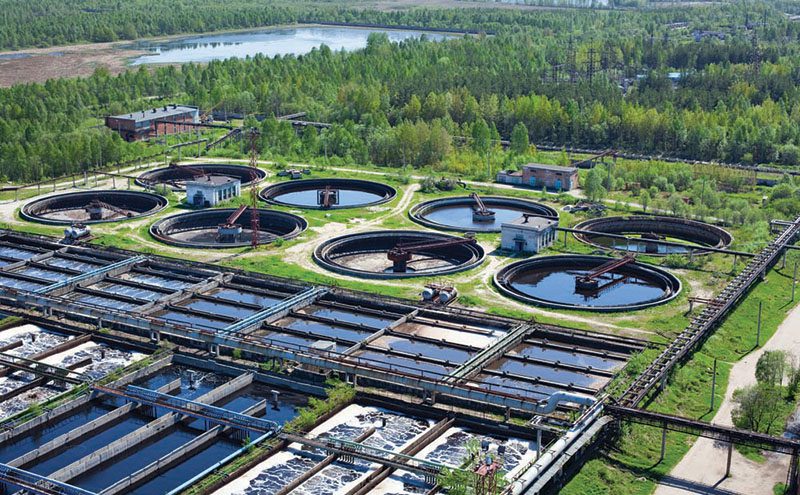A panel discussion at July’s AD & Biogas show brought together water and waste industry representatives to discuss the challenges and opportunities that will come with the introduction of an open market for sludge, an element of OFWAT‘s planned deregulation of the water sector scheduled for 2020. Envirotec reports.

We’ve come a long way since the days when sewage sludge was simply dumped in the sea untreated – a practice banned since 1998. The recognition of its value as a resource seems to be picking up pace. Over the past five years, “the means of treating sludge has changed quite a lot”, according to OFWAT engineer Alison Fergusson in her opening address, with more use of AD and less incineration, although still only around 20% of it goes to AD at the moment.
The term itself (sludge) can be a little slippery, with not-quite-the-same terms like “biosolids” and “organic waste” also in common use. Fergusson’s presentation confined it to “all the activities involved with the transport, treatment, recycling and disposal of sewage sludge”.
It is a small part of the value chain in the water industry, comprising around 5% of the sector’s assets. Traditionally it was seen as “the bit at the end”, as panellist Richard Laikin of PwC mused, and an activity where cost minimisation held sway as a priority – the focus being on the disposal of sewage sludge as a waste product. More recently the water industry has embraced the generation of energy from sludge, and more ambitious efforts to exploit sludge as a resource are appearing.
OFWAT consultation
As the economic regulator of the water sector in England and Wales, OFWAT has been evaluating the practicality of introducing open markets in the sludge sector, with the results of a consultation exercise recently seeing publication.
Fergusson said there was clearly scope for markets in sludge, and opportunities for firms to come up with “a better way of dealing with their sludge across company boundaries”. The possibility of synergies with the AD and organic waste sector also seems difficult to resist. “We can see that changes have been happening quite quickly in the way sludge is being treated,” she said.
OFWAT’s recent analysis looked at different firms’ operating costs for dealing with sludge, and recognised there were clear differences between them. It begged an obvious question: “Why wouldn’t you move sludge from a company that’s expensive to one that’s cheaper?” And yet, she said, that doesn’t seem to happen at the moment.
The scope of the analysis was confined to sludge located within 50km of another water company’s sludge treatment centre. Under such a scenario around 13% of the sewage sludge produced would be crossing company boundaries in this way.
With a market model, the traditional destination of sludge – that of a company’s own sludge treatment centre – becomes just one of a menu of options, she said. Another might be to hand it on to “some novel technology company that’s going to do something completely different with [it]” – maybe gasification. Or maybe a neighbouring water and sewage company might be the most cost effective choice for treatment. Or maybe a firm in the organic waste/AD sector would say ‘I’ve got a digester I could fill with sewage sludge and I could do it for such-and-such an amount’.
Such a vision requires “all sorts of things we don’t have in place at the moment”, she said, with a central concern being the setting of prices and how to go about that. She added that “we want to be very clear about the prices we’re setting for sludge activities”.

A sludge working group is currently involving stakeholders in discussions with OFWAT. It hopes to resolve issues such as how to value these sludge assets, and “all sorts of things about the risks of volumes of sludge going up and down and what that would mean to a water company”.
Farmers: The forgotten stakeholder
Steve Bungary of CIWEM, a consultant involved in the design and commissioning of AD plants for water companies, said an area the OFWAT consultation document appears to have skipped over is the concerns of the final stakeholder, the farmer – “the person most forgotten about”. The main issue here is with digestate quality – if it’s poor then the farmer might not take it. “There are already cases in Scotland where fields are being closed to commercial digestate”, he said, because of its poor quality.
He discussed some of the ways it can be improved, such as screening for materials like plastics, grit, eggshells and glass – all a serious concern if they end up on a farmer’s field. Some of the current screening practices, even with more than one layer of screening, still leave something to be desired, he suggested, showing an image of screened digestate containing plastics sufficient to cause a PAS110 failure.
Tying together the different standards and best practices
PAS110 is just one of a multitude of standards, codes of practice and legislation relating to sludge, biosolids and organic waste. The OFWAT work aspires to provide an umbrella interpretation of these, something he thought “looks very difficult”. But he said his conversations with the regulator have pointed out routes through the morass. He mentioned the Biosolids Assurance Scheme (BAS), which he believed could allow water and sewage firms operating in a deregulated market to demonstrate their effectiveness and their production of a good quality product.
Richard Laikin – PwC’s “Mr Water” in the words of the session’s chair Dr Piers Clark of the Isle Group – reviewed some of the complexities of deregulation. Water firms have been quite keen on generating revenue from energy production, he said, “and historically that tended to happen partly within and partly without their regulated business – it was very complicated how they made that work”.
While there has been a move to consider sludge alongside other activities in the value chain, like energy production, in a more optimised way, sludge treatment is still largely framed as a cost minimisation exercise. OFWAT’s efforts to encourage markets in the sludge area have “put a bit of a cat among pigeons, for some of the companies”. It has tended to be something of a Cinderella business, he said (one that doesn’t get the attention it deserves).
He observed that most water companies “have no idea of the unit costs of operating their sewage sludge/energy/transport assets”, and “no real idea about the tradeoffs – all the different ways they could be doing this”. Lots of work is now being done to try and pin down these unit costs.
The figures provided by the OFWAT document were “very high level”, he said in a later Q&A, and Fergusson said the data was weak partly because there hasn’t been any need to collect this data in the past, but that’s all changing now.
Laikin continued: “A lot of the water companies we’ve worked with can’t actually identify a sludge business”. Activities like sludge, energy generation and AD “had investments made in them and [were] operated by lots of people without single points of accountability”. So lots of firms are at a very early stage. And they’ll have to move quickly: “Companies are going to be having to put in their business plans for the next price review period, for the 2020 period onwards, within the next year or two”. And there’ll be a long period during which OFWAT determines its prices for the 2020 period onwards.
“And also, as you’ll discover, the business will be organised primarily around transport or primarily around environmental cost minimisation,” he said. “There are lots of hand offs, it’s very complicated.”
His own firm is trying to help water companies consider how well placed they are to offer different services, or whether it might make sense, for example, to enter into joint ventures or other collaborative arrangements with their peers (if located nearby). “They haven’t got very long to think about this stuff”.
A good time to talk to water firms
His advice to the audience – members of the AD and biogas industry – was that the water industry is keen to move from cost minimisation to value maximisation, and so was very interested in innovative technologies or service delivery innovations that could help here. “You’ll get a hearing at the moment,” he said.
Putting aside the perceived advantages of competition, in the later Q&A, the chair said there was also a downside: The water industry likes to collaborate, doesn’t like to share technology, and is very risk averse. Will competition in the sludge area disrupt collaboration?
In reply, Bungary said he didn’t think water companies collaborate as much as they like to think – the old water authorities did, until privatisation in 1989. But these firms are already talking about moving sludge around and asset optimisation, and market forces are going to drive that. From that perspective deregulation is a very positive thing.
Fergusson said OFWAT has the power to step in if problems arise and if it’s necessary to sort out anticompetitive practices. But we’ve “got to tread a careful line”. Laikin jokingly invoked “a management consulting bullshit word”, in suggesting that there would be “co-opetition” [sic]. He explained: “There’s going to be some collaboration between neighbouring companies where it makes sense to pull together such arrangements, and there’s going to be some competition between companies in different areas. And there’s still going to be lots of little monopoly areas where it doesn’t make sense for there to be competition or collaboration”.
Water firms and AD operators: Natural partners?
One audience member, Ian Harris of an insurance company, suggested joint ventures between water firms and AD operators seem like a common sense option, especially as AD developers lose their taste for building new plants, in the subsidy-lite landscape that’s emerging, and so will opt to partner with cash-rich utilities who have the land and the guaranteed feedstock.
He thought this would most likely feature lots of small, individual partnerships, rather than lots of water companies working with a big waste operator, a Biffa or Sita.
A question from Ian Goddard of Ham Baker, a technology firm active in the water and wastewater sectors, wondered how existing frameworks – at present an apparent barrier to the adoption of new technology in the risk-averse water industry – might adapt to this new climate, and the aspiration to improve system performance and cash yields.
Laikin said that much of the point of the kind of regulatory and pro-market changes OFWAT is trying to advance is to encourage innovation. He said many of the companies he was working with were starting to adapt in this way. “Because the status quo – just incrementally trying to take a bit of cost out of the process – isn’t going to be the winning strategy in the future”.
The chair Piers Clark said that “if ever there was a time to be talking to a water company and saying ‘I’ve got a magic bullet that could give you competitive edge’, now is the time to be having that conversation”.
Bungary qualified: “The issue that I think we come up against is: If there are a lot of existing supplier agreements in place, it’s very difficult to actually get in there”. Clark believed “there are routes in” and suggested an exchange of cards.
Bringing the whole session to a close, Clark asked each of the panel to reveal the one thing keeping them awake at night regarding sludge deregulation. Laikin: “The rules are not finalised, and therefore water companies which are not very good at making decisions till they know the rules of the game will put them off”. Bungary: “Digestate quality”. Fergusson echoed Laikin’s point: “We’ve got to sort out the rules – there’s a lot of work to do”.






